The SEO Metrics You Need To Report On
As an SEO specialist, I spend a lot of time working on websites to make them rank better in the organic search results. The team at Ingenuity Digital carry out impressive SEO work, but communicating the impact of that can fall short if you don’t present it in the right way to the people who matter most – your stakeholders.
This blog will discuss some of the most valuable SEO metrics I choose to present to a client to help them tell a clear and undeniably positive success story.
Ranking metrics
The bread and butter of SEO. As a search agency, it’s our responsibility to show that the rankings are improving and there are many ways you can do this. However, it’s important not to overwhelm your reporting with every metric and instead, focus on the ones that you know will paint the clearest picture.
Below are the metrics I tend to focus on:
SISTRIX Visibility
This is what I’d characterise as a ‘broad’ metric to report on. The SISTRIX visibility graph shows the visibility of your website based on the total number of ranking keywords and their associated ranking positions. If this goes up over time, it shows the website is ranking higher/for more keywords which translates into more traffic.
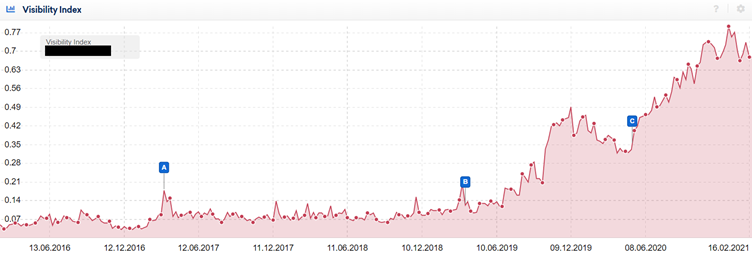
Average Rank
If you aren’t already, you should be tracking a specific set of keywords that you want to improve the ranking positions of. Once you’ve done this, you can monitor the average daily/weekly/monthly rank of those tracked keywords over time with the aim of improving this figure.
Depending on the website, this can still be broad, so I’d recommend categorising your keywords into specific groups, for example by product or service. That way, if you know you’ve been optimising a set of products or services, you can track the average ranking position for those groups and clearly demonstrate the impact it has made.
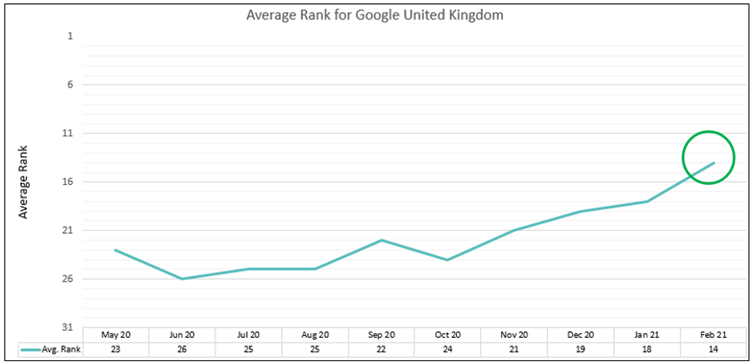
Traffic Forecast
This is one of my favourite metrics to use for rankings. It allows you to forecast the potential organic traffic being driven to your website based on ranking positions and associated search volumes of your tracked keywords.
This is an extremely useful tool to have up your sleeve that can quickly and efficiently tell the story of how your increased rankings are having a positive impact on potential website traffic. Below is an example of a client’s high search volume terms increasing its ranking position:

Website metrics
So, your rankings have successfully increased but how has this impacted your website? If you have software such as Google Analytics set up, you can easily measure a range of metrics that highlight the positive impact of SEO, such as:
Sessions
The sessions metric represents the number of people who have visited your website. You can drill into this data and see how many people have visited your website via the organic channel which SEO directly impacts.
However, sometimes sessions aren’t enough to demonstrate the value of SEO. By digging into your session data further, you can emphasise the results of your SEO efforts even more.
One thing I recommend doing with your session data is taking the amount of time you’ve been working on your SEO to establish the year-on-year uplift in organic sessions for each of those months. You can then plot this into a simple graph and, hopefully, it will show a clear upwards trajectory. This demonstrates that not only are your organic sessions up year-on-year, but the uplift is seeing consecutive increases month on month meaning it’s growing against the trend of the previous year.
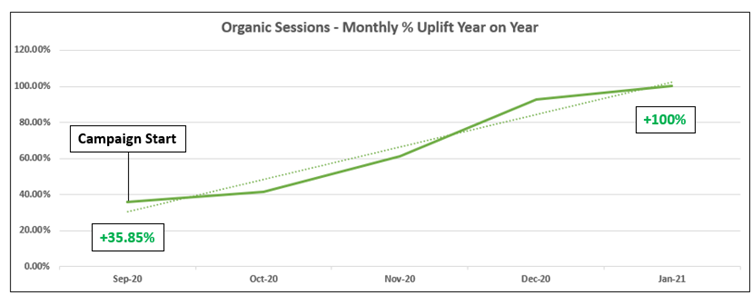
Specificity
Looking at overall sessions is worthwhile. However, sometimes it’s good to know how specific areas of your site are performing – especially if you’ve been concentrating more of your efforts there.
Using Google Analytics, it’s easy to be specific. Filter by landing page to see how that page was performing this time last year. If it’s performing better now, then that’s great – make sure you report on it.
Commercial KPIs
At the end of the day, a business decides to invest in SEO because they want to generate more revenue. Therefore, it’s crucial to ensure the website is set up to support this so you can clearly demonstrate a return on investment for your SEO efforts.
Revenue / Leads
Commercial value can be measured in a number of ways depending on the type of business you are. If you’re an eCommerce site, your Commercial KPIs (key performance indicator) will likely be transactions and revenue. However, if you’re a law firm it may be the number of website leads generated via form submissions. You may even use call tracking to attribute phone leads back to a marketing channel. Either way, you should be able to trace these commercial actions back to the organic channel to show just how valuable SEO is.
Below is an example of increased organic revenue after the start of an SEO campaign:

Another effective way to present Revenue / Lead data is showing the breakdown by Channel. This helps emphasise growth in the Organic channel over time and, with any luck, shows the gap between Organic and other channels widening over time as you deliver more Revenue/Leads than before.
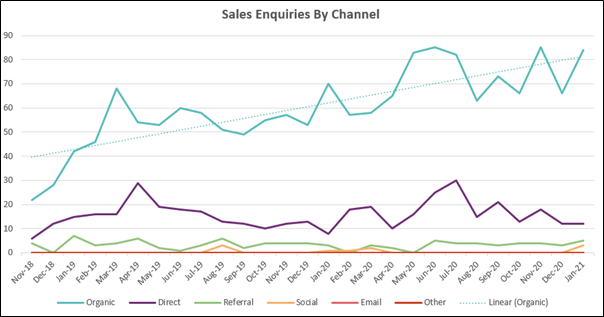
Assisted Conversions
A conversion can be a transaction, form completion, page visit – whatever your business deems as valuable. Using Google Analytics, you’re able to track conversions as described above. However, you’re also able to track ‘assisted’ conversions.
By default, Google Analytics attributes a conversion to a channel based on the ‘last click’ of that user. So, if a user found the site via organic, but then revisited at a later date via paid search and completed a conversion, it will be attributed to the paid channel.
But by using the Assisted Conversion tool in Google Analytics, you’re able to view the top conversion paths of the website and, more importantly, how many paths organic has been involved in but not credited for.
Below is an example of how these paths could look:
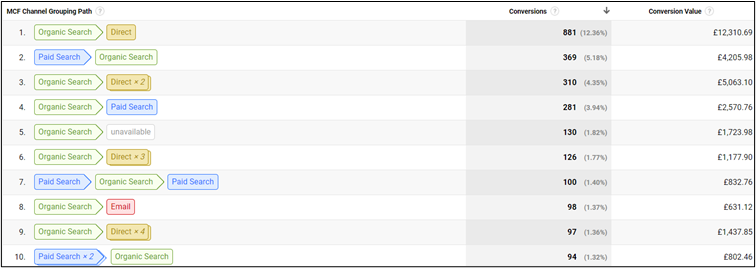
As you can see in this particular month, 881 conversions were made after a user discovered the website via organic search but then typed the website’s URL directly into their address bar at a later date to then convert.
When doing SEO, we’re really spoilt for choice with the number of metrics available. But it’s important to focus on the ones that demonstrate the most value in a clear and concise way. If you want to talk more about your SEO performance and how to prove the ROI of your organic efforts, please don’t hesitate to contact us.